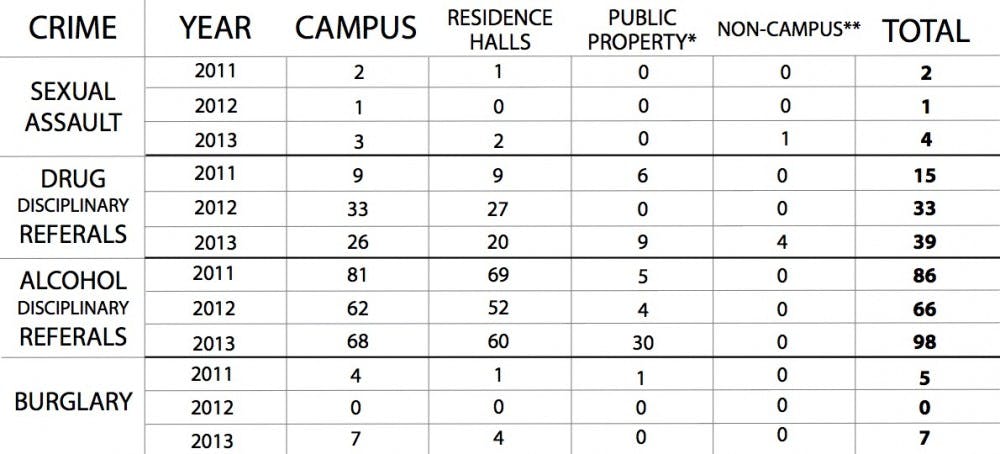Emily Neelon |
The 2013 Department of Public Safety Security and Fire Report shows increases in reports of sexual assault, alcohol and drug violations, but overall low incidence of crime.
UP is required to release this report annually in compliance with the Federal Government’s Student-Right-to-Know and Campus Security Act of 1990. The Security Act, also known as the Clery Act, went into effect after the rape and murder of 19-year-old Jeanne Clery at LeHigh University in 1986 and the backlash about unreported crime on college campuses that followed.
Sexual assault
Reported incidents of sexual assault increased from one in 2012 to four in 2013. Michael McNerney, communication and technology coordinator for Public Safety, said the recorded increase of sexual assaults at UP is probably due to increased reporting rather than more incidents.
“We know historically that sexual assaults are underreported,” McNerney said. “So we don’t necessarily see that (statistic) as we’re having more sexual assaults than before, but that more people are reporting what has happened.”
Gerald Gregg, director of Public Safety, believes this increase in reporting is due to the Green Dot program’s efforts to encourage students to speak up about violence on campus.
“We have an environment where we are a community against violence and encourage people to report any wrongdoing to them, so we expect to see an increase in the statistics of the reports,” Gregg said. “That’s not a bad thing. That means people feel safe and empowered and supported to report if something wrong has happened to them.”
The categorization of sex crimes has changed from two separate categories – forcible and nonforcible sex offenses – to one category of sexual assault. The change in name and division of this crime was implemented by the U.S. Department of Education. Sexual assault now encompasses any sexual act where consent is not given. A lack of consent means violence, intimidation or coercion is used by one party onto another.
Alcohol violations
Liquor law violations are the most reported crime on campus and rose almost 50 percent from 66 in 2012 to 98 in 2013.
Gregg, McNerney and associate director for community standards Natalie Shank were all unsurprised by this increase. Gregg attributes the rise in violations to better documentation by his officers, not a rise in drinking. Additionally, Shank has seen this trend in other college reports all over the country.
“That’s where the highest numbers are everywhere,” Shank said.
When dealing with alcohol violations in the residence halls, hall staff is most concerned about keeping students safe and secure, Shank said. In keeping with the approach of safety over scrutiny, the University changed the way they dealt with first time alcohol offenses during the 2012-2013 academic year. Instead of going directly into a hearing, students have a pastoral conversation with their hall director. A second offense leads straight to a hearing.
“We want people to be safe and (know) that they are welcome to come home,” Shank said.
Drug violations
Drug violations rose from 33 in 2012 to 39 in 2013. This increase is consistent with the trend throughout the Pacific Northwest’s institutions of higher education over the last few years.
Shank attributes UP’s high number of reports specifically to the University’s strict rules on drug use and abuse. First time drug offenses lead directly into suspension-level hearings and almost always involve marijuana use.
“We handle drugs in a very specific way and we take a very strong stance on drugs in our community so that’s why we maybe have more violations or referrals than other places,” Shank said.
Crime in a growing community
Gregg and McNerney predict that the increase in student population will lead to an increase in crime in 2014, but they are not making changes to staff size or training.
“I think we’re adequately and appropriately staffed at this point,” Gregg said. “If next year we have another large class, then that may prompt us to reconsider what an appropriate staff looks like”.
Overall, Gregg hopes to cultivate consistency among his staff when dealing with crime on campus.
“I don’t want one officer out there saying ‘O.K., I’m going to write up a report and submit it to student conduct for an underage student walking down the street with a beer’ while another officer says, ‘Dump out the beer and don’t do it again,’” Gregg said. “We need to be consistent so that we’re treating all of our students fairly and equitably”.
Crime not included in report
The report does not include two of the most prevalent crimes on campus: bike theft and Commons theft. The Clery Act does not require campus security to document these crimes.
While Public Safety is not required to report students shoplifting food items or utensils from the Commons, Gregg says his officers work to keep the most visited building on campus a safe space for students.
“We will work with and support Kirk [Mustain, manager of Bon Appetit] and his staff, but our job is not to monitor the open cases where somebody might take a Powerade without paying for it,” Gregg said. “We will work with them and support them if they call us and report something or ask for assistance. We try to have a presence there, not because we’re trying to catch a kid (stealing). We try to keep an eye on people that shouldn’t be there. It’s just a safety issue.”
Gregg says Public Safety strives to document all incidents of reportable crime.
“We’re very thoughtful about making sure if it’s reportable that we count it,” Gregg said. “If we’re not sure, we do research. We err on the side of caution in reporting something.”
Emily Neelon is a reporter for The Beacon. She can be reached at neelon17@up.edu.








